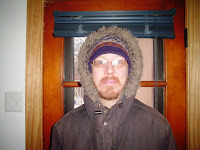NEW COLUMN: Inside the Outdoors -- Why Groundhog Day matters

(POSTED: 2/1/10) Groundhog Day? Could there be a sillier, more irrelevant holiday?
It doesn't honor one of our nation's heroes or commemorate an important historical event. It isn't a religious observance or a celebration our diverse culture (e.g. St Patrick's Day or Chinese New Year.) My kids could care less about such a holiday that has no traditional songs, no greeting cards at Hallmark, no TV specials (okay, there is a movie), and no magical being that delivers goodies. It doesn't even show up on my Sierra Club calendar! Arbor Day gets more respect.
Isn't it silly to gather on a cold February morning to watch a sleepy, fat squirrel hauled out of its hole to predict the next six weeks of weather?
Of course it is!
Who would believe there is any correlation between the weather conditions on one particular day and the severity of winter in the weeks that follow? It defies rational thinking! The respected (and federally funded) National Climate Data Center compared 12 years of predictions from Punxatawny Phil, the most well-known Groundhog Day groundhog, with actual climate data and found "no predictive skill" in the analysis of the animal's ability.
Even if it were true, why would the shadow (or lack thereof) cast by a wild animal be more indicative than the shadows of everything else casting shadows on the same day? What is so special about Marmota monax? (Er, that's Latin for a woodchuck, and oh, that's the more accepted common name for a groundhog.)
Silly and irrational it is without doubt. However, get ready for a shock because Groundhog Day, with its chubby marmot and shadowy meteorology is TOTALLY RELEVANT!
Follow me on a bit of backward history.
You see, the shadow-watching custom of Groundhog Day was brought to us by German-speaking immigrants who came to America in waves during the 18th century. Many German-American settlements sprang up in Pennsylvania, where the town of Punxatawny and its woodchuck Phil have become the hallmark representatives of the holiday.
Those immigrants had a folk saying that predicted the arrival of spring (or extension of winter) based on the shadow cast by an animal emerging from hibernation on the day of Candlemas, a Christian holiday on Feb. 2. Around 1887, the annual tradition of Groundhog Day began to be widely popularized in the American media. It gained steady attention and now, festivities in Punxatawny and many other places in America draw thousands of the faithful and the fanciful, and there is hardly a TV meteorologist that doesn't pay lip service to their animal colleagues.
I don't know if those 18th century people gave any credence to the notion of forecasting the weather this way, but with modern tools of meteorology, the logic of Groundhog Day seems foolish and its results have been proven inaccurate. So, let's go back in time a little more for some insight. Predictive weather sayings (like the one about the shadow) hearken back to a time when meteorology did not exist and when
agrarian communities depended on the return of spring for their very survival.
Imagine you are a peasant farmer of Medieval Europe. Winter is going strong and food supplies are dwindling. Any sign that spring was returning is a cause to rejoice. The Celtic cultures in pre-Christian Europe (best represented now in Ireland) invented their own holiday around this time called Imbolc, which meant "ewe's milk."
It must have been great to finally have some fresh milk when the alternative was starvation. So it went that folk sayings about the weather and festivals to observe the signs of spring evolved to give the people a glimmer of hope during a desperate time.
Nowadays, unless you are a subsistence farmer, variations on the yearly climate really don't carry the weight of life and death anymore. Still, the annual observance by this strange cult speaks deeply to a universal yearning among all of us who live in a winter-bound place. By the time February gets here, who isn't tired of the snow and icy roads, pained by the freezing cold, or depressed by the darkness?
I say we need a holiday right about now to remind us that winter will not last forever. Even as the hibernating animals return from the underworld, so is the
world of flowers and warm rains due for its re-birth.
This year, don't let Groundhog Day pass by without a thought. This is a wakeup call from nature. Bless the candles and join us in breathless anticipation of Marmota monax and its shadow.
For those adventurers thinking of seeking out your own wild woodchuck, be warned. In our part of the animals' range woodchucks rarely emerge from their dens earlier than the beginning of March. Just in time for Pulaski Day?
By Brian Winters, for ChicagoWildlifeNews.com
Contact: [email protected]
Brian Winters' life work is to build positive relationships between people and nature through the preservation of natural lands and the delivery of interpretive educational messages. Since 2000, Brian has been a naturalist at the River Trail Nature Center in the Forest Preserve District of Cook County. Brian has been working in the field of environmental education for 15 years, serving at local and county nature centers, as well as the Chicago Academy of Sciences and the Peggy Notebaert Nature Museum. Brian lives in the northern suburbs with his wife and two children.

0 comments: